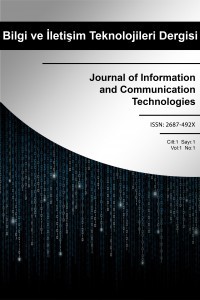İki Boyutlu Video Oyunlarında Yapay Zekâ (AI) Tabanlı Kendi Kendine Karar Veren Karakter Geliştirme Uygulaması
Hayatın hemen her alanında kullanılmaya başlayan Yapay Zekâ (AI) teknolojileri artık oyunlarda da kullanılıyor. Özellikle son zamanlarda birçok popüler video oyununda oyunu otomatik olarak oynayan bot sistemler için bu botların oyunun büyük ustalarını gelişmiş Derin Öğrenme (DL) yöntemleriyle yenmeleri mümkün hale geldi. Bu çalışmanın amacı, oyun karakterlerinin yetenekleri dahilinde ne yapacaklarına karar verebilen, Unity 2D Game Engine'de YZ tabanlı iki boyutlu bir video oyunu geliştirmektir. Oyun uygulamasında iki boyutlu oyun karakteri kullanıcı tarafından kontrol edilmektedir. Bu karakter, prosedürel düzlem oluşturma algoritmaları kullanılarak oluşturulan iki boyutlu bir oyun düzleminde hareket eder. Ayrıca oyunda mağlup edilen düşman sayısı ve ulaşılan seviye gibi istatistikler de kayıt altına alınmaktadır. Oyun Unity2D oyun motoruna dayalıdır ve C# ile yazılmıştır. Çalışmada sekiz farklı deney gerçekleştirilmiştir. Bu deneylerde oyuncunun karakter için tanımlanan farklı ekipmanlarla oyundaki başarı süresi ölçülmektedir. Bu süre 0,54 saniye ile 1,88 saniye arasında değişmektedir. Günümüzde bilgisayar oyunlarını daha iyi oynamak veya daha iyi oyunlar tasarlamak için YZ algoritmaları geliştiriliyor ve YZ algoritmalarını geliştirmek için yeni oyunlar tasarlanıyor. Bu bağlamda, bu çalışmanın YZ’nın bilgisayar oyunlarında kullanımına ilişkin literatüre katkı sağlayacağı değerlendirilmektedir.
Anahtar Kelimeler:
Video Oyunu Geliştirme, Prosedürel Düzeyde Üretim, Yapay Zekâ, Unity 2D, Video Game Development, Procedural Level Generation, Artificial Intelligence
Artificial Intelligence (AI)-Based Self-Deciding Character Development Application in Two-Dimensional Video Games
Artificial Intelligence (AI) technologies, which have started to be used in almost all areas of life, are now also used in games. Especially for bot systems that play the game automatically in many popular video games recently, it has become possible for these bots to defeat the grandmasters of the game with advanced Deep Learning (DL) methods. The purpose of this study is to develop an AI-based two-dimensional video game in Unity 2D Game Engine, which can decide what the game characters will do within their abilities. In the game application, the two-dimensional game character is controlled by the user. This character moves in a two-dimensional game plane that is created using procedural plane generation algorithms. In addition, statistics such as the number of enemies defeated and the level reached in the game are recorded. The game is based on the Unity2D game engine and is written in C#. In the study, 8 different experiments are performed. In these experiments, the player's success time in the game with different equipment defined for the character is measured. This time ranges from 0.54 seconds to 1.88 seconds. Today, AI algorithms are developed to play computer games better or to design better games, and new games are designed to improve AI algorithms. In this context, it is evaluated that this study will contribute to the literature on the use of AI in computer games.
___
- Pirovano, M. (2012). The use of fuzzy logic for artificial intelligence in games. University of Milano, Milano. Parlan, B. (2017). Independent Game Development: Prıce of Freedom. International Journal of Social Sciences and Interdisciplinary Studies, 2(2), 57-69.
- Pfau, J., Liapis, A., Volkmar, G., Yannakakis, G. N., & Malaka, R. (2020, August). Dungeons & replicants: automated game balancing via deep player behavior modeling. In 2020 IEEE Conference on Games (CoG) (pp. 431-438). IEEE.
- Prato, G. D., Feijoo Gonzalez, C. A., & Simon, J. P. (2014). Innovations in the video game industry: Changing global markets. Communications & strategies, (94), 17-38.
- Safadi, F., Fonteneau, R., & Ernst, D. (2015). Artificial intelligence in video games: Towards a unified framework. International Journal of Computer Games Technology, 2015.
- Sanders, A. (2016). An introduction to Unreal engine 4. AK Peters/CRC Press.
- Shannon, C. E. (1950). XXII. Programming a computer for playing chess. The London, Edinburgh, and Dublin Philosophical Magazine and Journal of Science, 41(314), 256-275.
- Stewart, J., & Misuraca, G. (2013). The industry and policy context for digital games for empowerment and inclusion. Joint Research Centre of the European Commission (JRC).
- Tunç, U. Z. L. U., & ŞAYKOL, E. (2020). Evaluating a player’s network class in a multiplayer game with fuzzy logic. Gümüşhane üniversitesi fen bilimleri enstitüsü dergisi, 10(1), 163-173.
- Tylor, E. B. (1879). THE HISTORY OF GAMES. Fortnightly, 25(149), 735-747.
- Westera, W., Prada, R., Mascarenhas, S., Santos, P. A., Dias, J., Guimarães, M., ... & Ruseti, S. (2020). Artificial intelligence moving serious gaming: Presenting reusable game AI components. Education and Information Technologies, 25(1), 351-380.
- Westecott, E. (2013). Independent game development as craft. Loading… The Journal of the Canadian Game Studies Association, 7(11), 78-91.
- Zackariasson, P., & Wilson, T. L. (Eds.). (2012). The video game industry: Formation, present state, and future Routledge.
- ISSN: 2687-492X
- Yayın Aralığı: Yılda 2 Sayı
- Başlangıç: 2019
- Yayıncı: Ramazan Yılmaz
